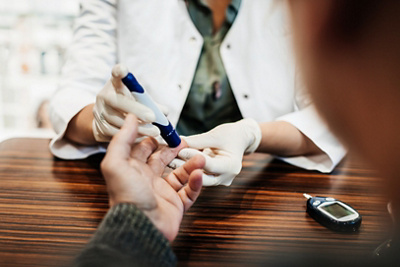Discover how one patient changed his lifestyle to control his diabetes – and how this condition can be managed.
During lockdown in 2020, André Valentine, a married 3 father of one, was shocked when his doctor told him he was diabetic. A fit 35-year-old, Valentine had always kept an eye on his glucose readings. “My wife is prediabetic, so whenever she was tested, I was tested too,” he says. “My glucose and which remained in the healthy, stable region (5mmol/L) for a year.
Type 2 diabetes diagnosis
During the 2020 lockdown, André’s health took a dip. “With no office routine, my diet took a turn for the worse as my eating habits went all over the place,” he recalls. My job was sedentary, and I wasn’t doing any exercise,” he recalls.
Although he didn’t think he was diabetic, André had tell-tale symptoms including extreme thirst, waking up several times at night to urinate and uncontrollable hunger cravings. “I visited my GP because I wasn’t feeling well,” he says. “After taking my glucose readings, she warned me that I am presenting as a Type 2 diabetic patient,” he says. Blood tests would later confirm the diagnosis and showed he was also hypertensive.
What is Type 2 diabetes?
According to Dr Narisha Sewgoolam, a physician at Mediclinic Pietermaritzburg, Type 1 diabetes, which occurs in early childhood, Type 2 diabetes is mostly found in adults. With Type 1, there is a deficiency in the amount of insulin the pancreas produces. With Type 2 the problem is insulin resistance, where cells become less responsive to insulin.
“Type 2 diabetes is also known as lifestyle diabetes, because it is triggered by a person’s long-term unhealthy lifestyle,” she says. This includes a sedentary job, poor diet, smoking, drinking alcohol and stress. While André had recently quit smoking and hardly ever drank, he thinks his diabetes may have been triggered by bad eating habits, spending most of his days in a desk chair, a few extra kilograms, and the stress of intense deadlines.
How is Type 2 diabetes treated?
Dr Sewgoolam suggests a multidisciplinary approach to treating diabetes. “This means using medication to manage blood sugar levels, while also getting a physician and dietician involved.” The most common medications are Metformin and Gliclazide.
André was put on both types of medication, as well as statin and diuretic for his hypertension. “I also started a diabetic diet which focuses on healthy food preparation and cutting down on high sugar content and foods,” he says. “It was challenging at first, but now I have mostly found a balance. However, I admit I sometimes let a little loose around special occasions, and even have a drink.”
Dr Sewgoolam points out that alcohol can have an adverse effect on diabetic medication and can cause hypoglycaemia. She advises that, if a person with Type 2 is going to have a drink, they should have a decent meal beforehand. This is because food slows down the absorption of alcohol into the bloodstream. “Most importantly, don’t stop your medication, drink slowly and know your limits,” she says.
Type 2 diabetes can be managed
Dr Sewgoolam says that although diabetes isn’t curable, its effects can be reversed through a controlled diet and weight loss. This in turn leads to controlled blood sugar without medication. “You can’t escape it completely, since diabetes is an ongoing condition, but modern modalities such as a strict low carbohydrate diet and regular exercise can hold it at bay,” she says.

